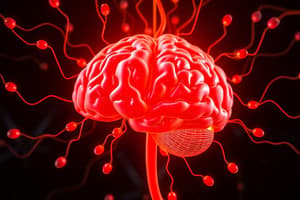Podcast
Questions and Answers
What is a significant limitation of the Dopamine Theory of Addiction?
What is a significant limitation of the Dopamine Theory of Addiction?
- It suggests that all individuals will become addicted.
- It assumes environmental cues do not affect drug use.
- It fails to recognize neurotransmitter involvement in addiction.
- It overlooks the role of craving in addiction. (correct)
What percentage of rats typically exhibit a truly addictive phenotype?
What percentage of rats typically exhibit a truly addictive phenotype?
- 50%
- 15% (correct)
- 25%
- 5%
Which neurotransmitter is primarily associated with craving in addiction?
Which neurotransmitter is primarily associated with craving in addiction?
- Glutamate (correct)
- Dopamine
- Serotonin
- Norepinephrine
Which animal model is commonly used to study drug addiction?
Which animal model is commonly used to study drug addiction?
What symptoms can arise from drug addiction?
What symptoms can arise from drug addiction?
What is the current challenge regarding cravings in addiction treatment?
What is the current challenge regarding cravings in addiction treatment?
In the context of drug self-administration in animals, which drug has NOT been typically self-administered?
In the context of drug self-administration in animals, which drug has NOT been typically self-administered?
Which brain areas are implicated in the learned associations related to craving?
Which brain areas are implicated in the learned associations related to craving?
What is the main role of dopamine in the context of addiction?
What is the main role of dopamine in the context of addiction?
Which statement most accurately describes the concept of tolerance in substance abuse disorders?
Which statement most accurately describes the concept of tolerance in substance abuse disorders?
How does the incentive-sensitization theory explain addiction?
How does the incentive-sensitization theory explain addiction?
What is one of the neuroadaptive changes that can occur in an individual with substance dependence?
What is one of the neuroadaptive changes that can occur in an individual with substance dependence?
Which route of drug administration typically leads to the fastest and most intense increase of dopamine in the brain?
Which route of drug administration typically leads to the fastest and most intense increase of dopamine in the brain?
What is a potential limitation of the dopamine theory of addiction?
What is a potential limitation of the dopamine theory of addiction?
Which pharmacological treatments are commonly used to alleviate symptoms of addiction?
Which pharmacological treatments are commonly used to alleviate symptoms of addiction?
Animal models of addiction are primarily used to study which aspect of substance use disorders?
Animal models of addiction are primarily used to study which aspect of substance use disorders?
What is a limitation of the dopamine theory of addiction?
What is a limitation of the dopamine theory of addiction?
Which brain regions are noted for their involvement in addiction mechanisms?
Which brain regions are noted for their involvement in addiction mechanisms?
How do individual differences affect addiction susceptibility?
How do individual differences affect addiction susceptibility?
What is suggested by animal models used in the study of addiction?
What is suggested by animal models used in the study of addiction?
Which of these substances is most likely to result in rapid dopamine release?
Which of these substances is most likely to result in rapid dopamine release?
What role do glutamate transmissions play in addiction according to research?
What role do glutamate transmissions play in addiction according to research?
Which of the following best describes craving mechanisms in addiction?
Which of the following best describes craving mechanisms in addiction?
What does research say about pharmacological treatments for addiction-related symptoms?
What does research say about pharmacological treatments for addiction-related symptoms?
Flashcards are hidden until you start studying
Study Notes
Individual Differences in Addiction
- All abused drugs elevate dopamine transmission; however, only a small percentage of individuals develop addictions.
- Among rats, a similar percentage become addicted, distinguished as high responders vs. low responders.
- Approximately 15% of rats exhibit a genuine addictive phenotype.
Limitations of Dopamine Theory
- Craving plays a significant role in addiction, with glutamate as the primary neurotransmitter involved.
- Learned associations between environmental cues and drug use occur in the prefrontal and orbitofrontal cortices.
Symptoms of Addiction
- Symptoms include anxiety, depression, and psychosis.
- Pharmacotherapies are available for treatment, but effective methods to curb cravings remain limited.
Animal Models of Addiction
- The drug self-administration method is a common technique, where animals (mice, rats, monkeys) self-administer various drugs, particularly cocaine, amphetamine, heroin, and nicotine.
- Notably, drugs like LSD and THC are less commonly self-administered.
- Rats can also self-administer alcohol and stimulate brain areas linked to reward.
Key Concepts in Addiction
- Tolerance develops as the effect of the drug diminishes with repeated usage.
- Withdrawal symptoms manifest when chronic drug use is halted.
- Sensitization reflects an increased response to drugs post repeated administration, indicating long-term neuroadaptive changes influenced by drug use.
Incentive-Sensitization Theory of Addiction
- Proposed by Terry Robinson and Kent Berridge in 1993, highlighting compulsive use and relapse.
- Emphasizes a stark increase in 'wanting' drugs over 'liking' them, suggesting neurological adaptations that favor drug seeking rather than pleasure.
Role of Dopamine in Addiction
- Substance addiction is defined by the speed and magnitude of dopamine increase in the nucleus accumbens, referred to as the "rush."
- Factors affecting this include drug potency and route of administration: oral, subcutaneous, intramuscular, intranasal, inhalation, or intravenous.
Summary of Addiction Components
- Drug addiction encompasses both psychological and physical elements.
- Fast routes of administration significantly enhance dopamine levels, influencing addiction potential.
- The dopamine theory has limitations; animal models and brain imaging reveal critical regions in addiction, including the nucleus accumbens, striatum, hippocampus, amygdala, orbitofrontal cortex, and prefrontal cortex.
Studying That Suits You
Use AI to generate personalized quizzes and flashcards to suit your learning preferences.




